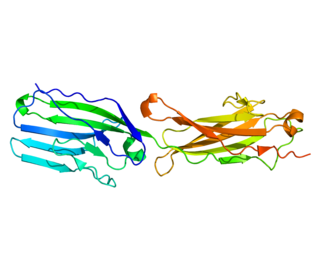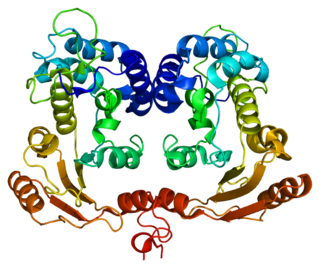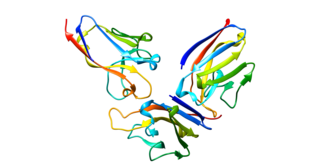
CD11c, also known as Integrin, alpha X (ITGAX), is a gene that encodes for CD11c.

Toll-like receptor 4 is a protein that in humans is encoded by the TLR4 gene. TLR4 is a transmembrane protein, member of the toll-like receptor family, which belongs to the pattern recognition receptor (PRR) family. Its activation leads to an intracellular signaling pathway NF-κB and inflammatory cytokine production which is responsible for activating the innate immune system.

Lymphocyte antigen 96, also known as "Myeloid Differentiation factor 2 (MD-2)," is a protein that in humans is encoded by the LY96 gene.

CD244 also known as 2B4 or SLAMF4 is a protein that in humans is encoded by the CD244 gene.

Basal cell adhesion molecule, also known as Lutheran antigen, is a plasma membrane glycoprotein that in humans is encoded by the BCAM gene. BCAM has also recently been designated CD239.

SLAM family member 6 is a protein that in humans is encoded by the SLAMF6 gene.

Carcinoembryonic antigen-related cell adhesion molecule 3 (CEACAM3) also known as CD66d, is a member of the carcinoembryonic antigen (CEA) gene family..

Interleukin 21 receptor is a type I cytokine receptor. IL21R is its human gene.

Bst1 is an enzyme that in humans is encoded by the BST1 gene. CD157 is a paralog of CD38, both of which are located on chromosome 4 (4p15) in humans.

Fc receptor-like protein 5 is a protein that in humans is encoded by the FCRL5 gene. FCRL5 has also been designated as CD307.

Signal-regulatory protein beta-1 is a protein that in humans is encoded by the SIRPB1 gene. SIRPB1 has also recently been designated CD172B.

CD320 is a human gene.

Signal-regulatory protein gamma is a protein that in humans is encoded by the SIRPG gene. SIRPG has also recently been designated CD172G.

Single Ig IL-1-related receptor (SIGIRR), also called Toll/Interleukin-1 receptor 8 (TIR8) or Interleukin-1 receptor 8 (IL-1R8), is transmembrane protein encoded by gene SIGIRR, which modulate inflammation, immune response, and tumorigenesis of colonic epithelial cells.

Immunoglobulin superfamily, member 2 (IGSF2) also known as CD101, is a human gene.

CD300A is a human gene.

TIR domain-containing adapter molecule 2 is a protein that in humans is encoded by the TICAM2 gene.

Cytospin-B is a protein that, in humans, is encoded by the CYTSB gene.

Ras-related protein Rab-7b is a protein that in humans is encoded by the RAB7B gene.

Protein THEMIS is a protein encoded by the eponymous THEMIS gene.




















